By Gail Cochrane
Liberty Wildlife Volunteer
Picnics and playdates, dinners and game nights. We all love it when our friends come over to visit. You can invite wild friends to drop by as well. It’s as simple as providing food, shelter, space and drink, just like you do for your human friends.
Wild friends need our help these days, especially in urban areas like Phoenix. 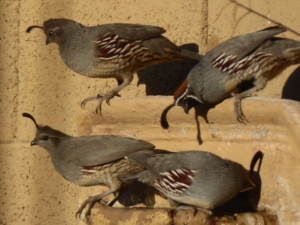 If you look around, you’ll notice plenty of pavement has been laid down so we can get about, and lots of housing sits on what used to be desert habitat. But most homes have some open space around them, and what humans do with that space can make a big difference in the lives of our wild brethren.
If you look around, you’ll notice plenty of pavement has been laid down so we can get about, and lots of housing sits on what used to be desert habitat. But most homes have some open space around them, and what humans do with that space can make a big difference in the lives of our wild brethren.
Food, shelter and nesting sites can be added to a backyard or even a patio as easily as putting in some native plants. These desert natives have long standing relationships with the animals of the area. Many attractive plants such as fairy duster and brittle bush grow an abundance of seeds which are food for birds and cute critters like antelope squirrels and pocket mice.
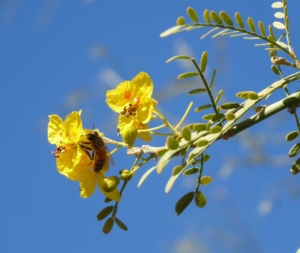 Native plants provide homes for insects that hide and feed among the leaves and branches. These insects are excellent high protein food for birds, many of whom feed insects to their young. Chuparosa, fairy duster and globe mallow provide nectar for hummingbirds and butterflies. Desert hackberry and wolfberry are prickly plants that grow delicious fruits and offer cozy shelter for birds and insects.
Native plants provide homes for insects that hide and feed among the leaves and branches. These insects are excellent high protein food for birds, many of whom feed insects to their young. Chuparosa, fairy duster and globe mallow provide nectar for hummingbirds and butterflies. Desert hackberry and wolfberry are prickly plants that grow delicious fruits and offer cozy shelter for birds and insects.
Letting these plants grow according to their natural form also helps wildlife. If you want your plants to keep their flowers, fruits and seeds, you need to resist the urge to tidy them up by trimming and shearing. Native plants provide shelter for birds, lizards and insects within their shady branches and on the slightly moist ground underneath. 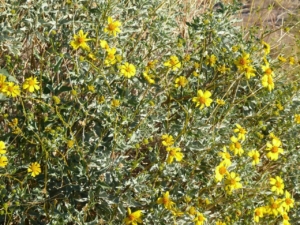 See how easy it can be?
See how easy it can be?
One last detail, and an important one, is water. You will need to water your plants, but natives are pretty thrifty, and they won’t need as much as non-native plants. Your wildlife guests will also appreciate water, some more than others. Pocket mice and antelope squirrels drink hardly any water. These amazing animals get all of the moisture they need from the seeds they eat. Stored in cool, humid burrows, the seeds plump up with absorbed moisture.
But many of the most common birds need water to drink. For your backyard garden it can be as simple as setting out a ceramic dish with water and some small rocks in it. Be sure and change the water daily as it will evaporate quickly and some diseases do spread among bird populations at water sources. A recirculating fountain is another way to add water to your wildlife welcome. Providing water will attract Gambel’s Quails, Northern Mockingbirds, Mourning Doves, Anna’s Hummingbirds and more.
A good host is the key to any great gathering, because that’s who makes it all happen! When you are host, be sure and take note of your wildlife guests and get to know their habits. Maybe keep some binoculars handy, because you are sure to have visitors.
Kid Stuff
Nurturing Nature
By: Carol Suits
Liberty Wildlife Volunteer
The Superhero Club is back in action!
Kids are superheroes when they help nature. Be a superhero and find lots of ideas here to make your yard more wildlife-friendly!
How many different living things are in your backyard, school yard or neighborhood? Find the map activity below to help answer this question.
Why doesn’t all wildlife live in the same place?
An elephant can’t live in Phoenix, right? (Except at the zoo where people have learned about the elephant’s habitat needs and worked to supply those needs.) A habitat is a place where a living thing makes its home. That living thing could be a fox, worm, rose bush, spider, Gila monster, bee, butterfly, or eagle! For something to live, it must have the right amount of food, water, shelter, and space which makes up its habitat.
Example: For birds, a good habitat has everything a bird needs to survive.
FOOD: Just like you, birds need a healthy diet. Different birds eat different foods, for example seeds, insects, and fruit.
WATER: Birds need clean water for drinking and bathing.
SHELTER: Birds need safe places to sleep and raise young, and shelter from bad weather. Birds find cover in trees, bushes, and structures made by people.
SPACE: Birds need room to grow and live. They need to be able to find enough of everything they need like food, water, and shelter in the place they call “home.”
Your map will help you decide if your yard or space needs more water for wildlife. Or more food. Maybe a place for shelter? Once you figure out what you need, see if there’s an activity here to help you. Can you think of your own plan to help wildlife?
Think about many living things for the space you plan to help.
https://education.nationalgeographic.org/resource/habitat Kids in 5th and 6th grade might like this habitat information.
Make a Nature Notebook for your habitat work so you can share your activities with your family, your friends and Superhero Club members. Add your map work to your Nature Notebook.
https://www.thegreenhour.org/nature-notebook/fall-nature-notebook/
Bird Habitat Map
Journal Page: Improving Bird Habitat Map
Name: _______________________________________________________________
Location: ______________________________________________________________
Draw a map of your schoolyard or your backyard.
- Look for different kinds of land cover. Sketch the boundaries of areas covered by pavement, buildings, lawn, grasses, flowers/herbs, forest, shrubs, water, wetlands, and bare ground (dirt, gravel, or sand).
- Check where birds might find food, water, and cover. Mark these spaces on your map.
- Finally, add information to you r map to indicate bird‐friendly plants or objects such as bird feeders, water sources, and brushy areas.
- What is one way you can make your schoolyard or backyard more bird‐friendly? Did you decide to supply food, water, or shelter? What is your plan? Who can help you? Talk to friends for their ideas!
- If you decide to improve the habitat for birds in your backyard, talk with the adults in your home about your plan.
- If you decide to improve the habitat for birds your schoolyard, talk with your teacher to find out how to get started.
- When you finish your habitat changes add them to your map. Good job!
- Now check if other living things need better habitat and after you’ve helped improve the habitat for those living things, add the changes to your map.
YOU are a Superhero!
Here’s some habitat ideas:
Habitat Need – Food
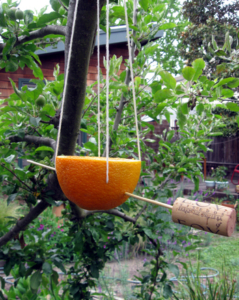 An orange cup feeder
An orange cup feeder
https://www.youtube.com/watch?v=CW7UYp9kLi0 Use recycled stuff to make bird feeders
https://www.audubon.org/news/pumpkin-bird-feeder-makes-happy-harvest-birds Pumpkin bird feeder
https://www.youtube.com/watch?v=3cztn15inP8 Cheerios bird feeders
diy-bird-feeder.pdf Use a slinky toy
https://tinyurl.com/3u96yez8 Bird feeders from milk cartons for younger kids.
https://www.youtube.com/watch?v=lfbE5AUG5tM Make a one-stop bee café with butterfly food!
You may want to start a butterfly garden to feed nectar to pollinators and produce seeds for new plants! If you don’t have space for a garden, try using a pot or some other container you have at home.
https://kidsgardening.org/resources/pollinator-pals/ Meet some cool pollinator critters here.
https://kidsgardening.org/resources/garden-activities-plant-a-butterfly-garden/
https://kidsgardening.org/resources/gardening-basics-grow-milkweed-to-help-monarch-butterflies/
Habitat Need – Water
https://www.wildlifetrusts.org/actions/how-provide-water-wildlife
https://www.youtube.com/watch?v=GqcmkIDRhLU Water for bees and butterflies
https://www.youtube.com/watch?v=bsZYMH5xRTA Make a Puddle Patch for butterflies
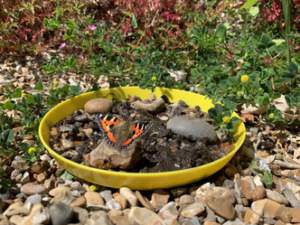 A puddle patch
A puddle patch
https://tinyurl.com/5n6eb9ns Watch this girl make a bird bath and bird feeder
Habitat Need – Shelter
Birds, bats, butterflies, bees, toads, insects, tortoises, and many other animals need shelter. You can get help to build a wildlife home. Decide what you’d like to build, find some examples, and get an adult to help you get started.
https://www.youtube.com/watch?v=2ertDBp9_eA Milk carton bird houses These are easy to make.
https://tinyurl.com/Ledge-nests
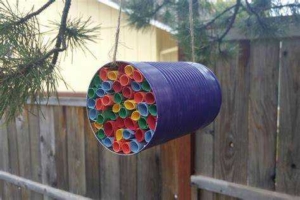

https://tinyurl.com/Solitary-bees-and-houses
https://tinyurl.com/Bee-House-Supplies
https://housegrail.com/diy-bee-house-plans/
The Superhero Club will meet Saturday, October 8th, at 9:00 at Liberty Wildlife!
Club members can start their habitat work before we meet. Be sure to bring your Fall Nature Notebook with you to share what you’re working on. There will also be material if you need to make a notebook at Liberty.
We will be meeting some cool animals and learn about their habitat needs.
Superheroes earn points for activities they work on, earn awards, and get to be in a future Kid Stuff publication!
For more information about the Superhero Program contact Carol Suits at
A very big THANK YOU to Ezra Kader, age 10, who volunteered to research these activities for our Superhero Club over the summer. He did an outstanding job! Thanks also to Aaron Kader, Ezra’s dad, who supported his efforts.
Puzzles! You will like these, especially the last one which is a special pollinator!
https://www.jigsawplanet.com/?rc=play&pid=25b5516b5f53
Global Bird Rescue Week
By: Craig Fischer
Liberty Wildlife Volunteer
Nest blow downs, animal encounters, and human causation: these are a few of the many causes that birds and other animals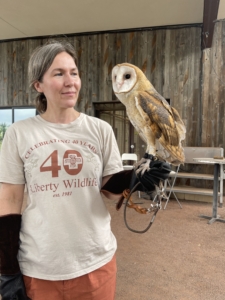 require attention from Liberty Wildlife. Often, our first responders are the volunteers from Rescue & Transport and our Hotline teams. These teams will be recognized during Global Bird Rescue Week, Oct. 3-9.
require attention from Liberty Wildlife. Often, our first responders are the volunteers from Rescue & Transport and our Hotline teams. These teams will be recognized during Global Bird Rescue Week, Oct. 3-9.
The week will call attention to the plight of migratory birds as they head south to their winter grounds. Often these migration routes take the birds through major metropolitan areas where the city lights and tall buildings can confuse the birds. Thousands of birds perish or receive severe injuries flying into a building with reflective windows.
Our Education teams will present several of our animal ambassadors who were rescued but were unable to be returned to the wild during open hours, 10am-1pm, on Wednesday, Oct. 5; Saturday, Oct. 8; and Sunday, Oct. 9. You can also learn about the care each animal receives at Liberty Wildlife, how to contact us with an animal emergency, and how to prevent window strikes at home.


